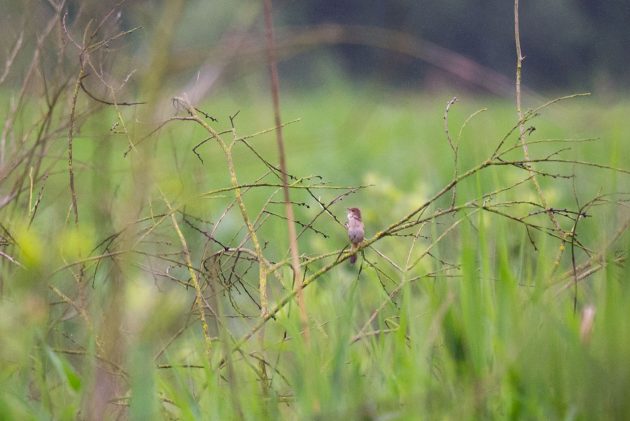The weather around Bonn was unpredictably volatile in May, with some extremely sunny days followed by a series of cold and wet ones. This made being outside slightly tricky, and I got me caught in the rain by surprise several times. I suppose it’s normal for weather to vary unexpectedly (and for the varied rain radars to be inaccurate), but leaving office on a sunny afternoon and getting home quarter-hour later drenched to the bone seems somewhat unusual. Either way, I resorted to not planning far ahead (at the least almost about weather, not the opposite features of my life) and so one morning before work I packed my birding equipment and decided to remain the night in Mannheim to go to the Wagbachniederung the subsequent morning: the weather looked promising. I’ve been to the Wagbachniederung before (see a previous post) and it gave the impression of a great site to go to again, being barely easier to achieve than the similarly interesting nearby Saalbachniederung when traveling by public transport. Questioning my reliance on spontaneity, the rain was drumming onto the roof of the hostel after I woke up in my dorm bed in Mannheim at 4AM. By the time I arrived on the Wagbachniederung, the rain had fortunately cleared making way for a light-weight drizzle for the remainder of the morning. Not ideal conditions, however it seemed as if the birds remained more energetic and were singing for longer as the warmth built up much later.
Common Nightingales and Common Cuckoos where calling all over the place. While I’ve heard and seen each species multiple times, these atmospheric songs in the humid dawn, with songs of other species and the sound of water dripping through the foliage in the background, was already a highlight of the day. As it became a bit brighter, I attempted to see a number of the Common Nightingales but was mostly left with fleeting dark shapes in the undergrowth before a bird offered me a good view. A Common Cuckoo seemingly needed to take things more slowly with its wet plumage, allowing me to watch it from a hide because it was drying itself.
Common Cuckoo
The reeds and waterbodies in the wetland host many waterbirds with chicks, including Black-necked Grebe and Red-crested Pochards. It looked as if it would me that this species has a far more liberal approach to raising offspring in comparison with that other waterfowl: the young chicks were sometimes exploring the wetland dozens of meters away from the mother – to date I believe I’ve all the time seen ducklings to follow their parents quite closely. I ponder if the helicopter pochard parent might be a thing in a couple of years.
Black-headed Gulls were also breeding in the wetlands in large numbers, becoming very agitated when a Western Marsh-Harrier quartered low over the reeds.
 Red-crested Pochard
Red-crested Pochard
 Western Marsh-Harrier
Western Marsh-Harrier
Other birds didn’t make an excessive amount of of a fuss in regards to the harrier, including a Savi’s Warbler whose cricket-like buzzing I heard before eventually spotting it far-off. This was a lifer I’d been hoping to see for some time, and my first Locustella. I initially wrote “second” as an alternative, having seen a Pallas’s Grasshopper Warbler in Sri Lanka, but then realized it’s not a Locustella. Then I remembered a sighting that also haunts me now and again: the glimpse of a bird near my home in South Africa around 10 years ago which I’m still 99.9% sure was a River Warbler, however the missing 0.1% forced me to just accept the Savi’s Warbler as my first Locustella. While I continually remember some sightings of birds I’ll never know what species they were, I quite enjoy this as after I see them in the future (assuming I’ll), it can be all of the more satisfying they usually remain by some means special even after I see them time and again in the longer term.
 Savi’s Warbler
Savi’s Warbler
To round of this post after all, the obligatory Purple Herons (I’m unsure whether to call it a special or a normal species of the Wagbachniederung) must be included. Their breeding mounts in the wetland were removed, probably because things were getting uncontrolled with photographers. I feel that is a great thing as probably reduces the number of holiday makers, which can put quite a strain on other wetland species as well.
 Purple Heron
Purple Heron